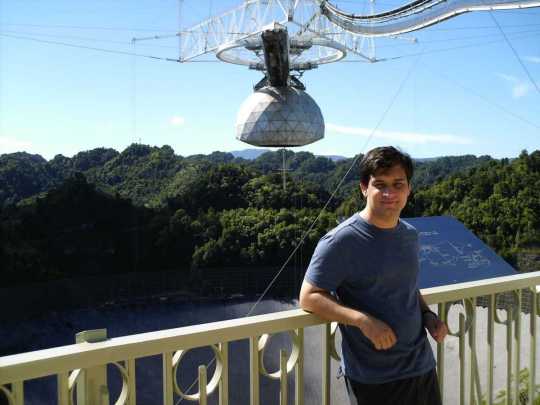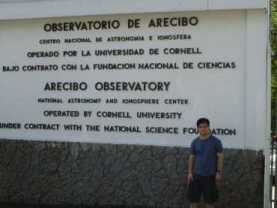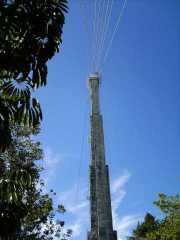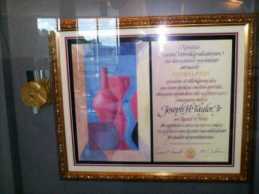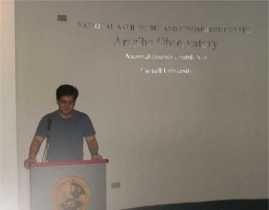…and I also wouldn’t normally use this blog to inflict personal photos on you all, especially vacation photos.
But today I’m going to make an exception to both rules.
Anyone care to guess where I was last week?
Yes, you guessed it: after a three-hour plane flight and a two-hour drive along narrow, winding backcountry roads, I arrived at the Arecibo Observatory in Puerto Rico, the largest radio telescope in the world.
Here’s me at the observatory complex’s front gate:
The observatory itself was at the top of a long hill. Along the path on the walk up, there are scale models of the solar system. Here’s the Sun (at the start of the walk) and a little way up, the Earth:
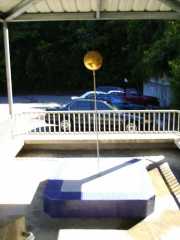 |
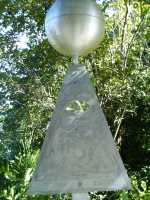 |
Further up the hill, the observatory itself rises into view above the trees. The lush tropical valley it’s situated in is a gorgeous enough sight, but with the observatory towers rising above the treetops, it was practically a spiritual experience. (I imagine this must be how Muslims on pilgrimage feel when the Kaaba finally draws into sight.)
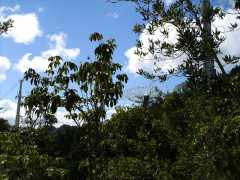 |
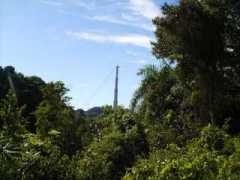 |
There are three towers which hold the support cables for the main reflector that’s suspended over the dish. Here’s one of them from below, in a shot that tries to convey just how huge they are:
Before seeing the observatory, there’s a small visitor center and museum. Here’s a shot from inside, one of the Nobel prizes that was won with Arecibo’s aid – by Joseph Taylor and Russell Hulse, for the discovery of the first binary pulsar.
The next two pictures are kind of a funny story. After touring the exhibits in the visitor center, which were okay but nothing spectacular, I was becoming impatient to see the telescope itself. But the visitor center didn’t have any windows that looked out onto it directly, and there didn’t seem to be any way to get outside. I was starting to worry I’d come all this way for nothing. Then, on the second floor of the visitor center, I noticed a hallway leading back into some staff offices. There weren’t any signs saying Employees Only, but it didn’t seem like an area meant for casual visitors. I peeked in and noticed, at the end of the hallway, an employee lounge with picture windows that looked out onto the telescope. It was Saturday, so the adjacent offices were empty, and there were no employees of the visitor center around.
Well, what would you have done?
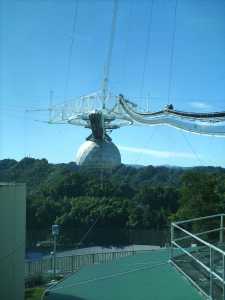 |
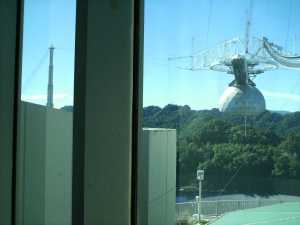 |
As it turns out, my cunning attempt at espionage was unnecessary. Through an ordinary, nondescript exit door at the back of the visitor center (and I don’t know why it wasn’t marked more prominently), you can stand on a platform overlooking the dish itself.
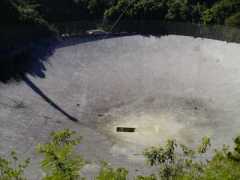 |
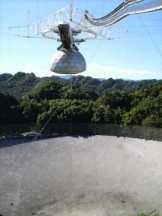 |
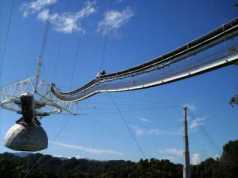 |
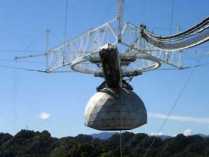 |
The sheer sense of scale doesn’t fully come through in the pictures, though I tried to take shots that would convey it. The telescope is gigantic: the dish is almost a thousand feet across, and the reflector suspended over it is the size of a house. It’s built into a giant natural valley in the jungle terrain.
And finally, here’s me when I was invited to be the keynote speaker at a scientific colloquium that was going on while I was at the observatory. (Not really.)
Unfortunately, despite all the trail-blazing discoveries it’s brought us, the future of Arecibo is threatened. Thanks to a selfish and short-sighted Congress, the National Science Foundation has been forced to make cutbacks in the past few years. Among other things, the NSF has told the staff of Arecibo (and Cornell University, which operates the telescope) that they must find outside sources for half of their budget within three years, or else the great observatory faces closure.
It doesn’t have to be this way. The annual cost of operating Arecibo is a mere $8 million – small change, on the scale of the federal government. But while the government refuses to pay this comparatively paltry amount to continue to survey the deepest reaches of the universe, it continues to flush hundreds of billions of dollars into a wasteful, endless nightmare of war in Iraq. A tiny fraction of that money, if diverted to worthier causes, could pay enormous dividends both in fundamental science and elsewhere.
As grateful as I am to have had this experience, I don’t want to be one of the last people to enjoy it. Arecibo deserves to be fully funded and to continue operating for many more years. The well of discovery has not yet come close to running dry, and if we seal it off, we’ll be doing ourselves an enormous, senseless disservice. A bill, HR 3737, has been introduced in the House of Representatives to provide for Arecibo’s funding. If you’re an American, I ask you to contact your congressional representative and ask them to lend their support.
